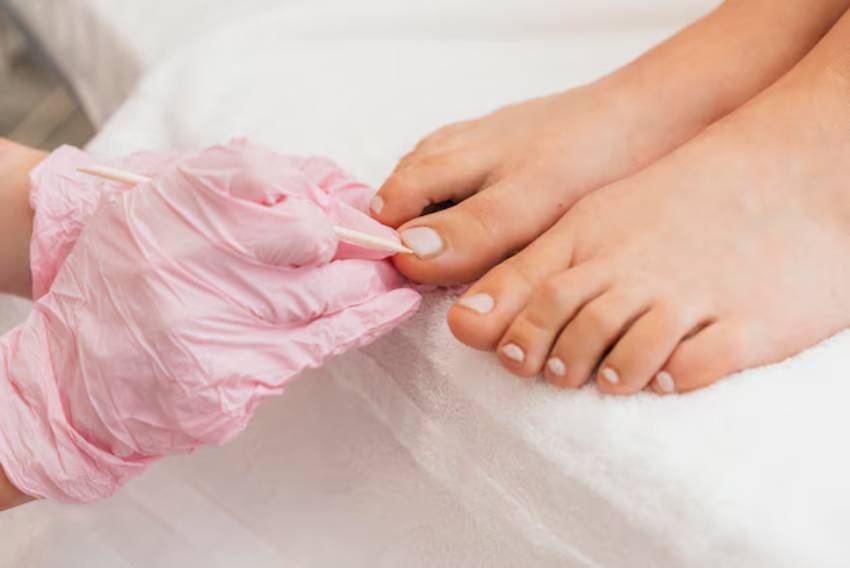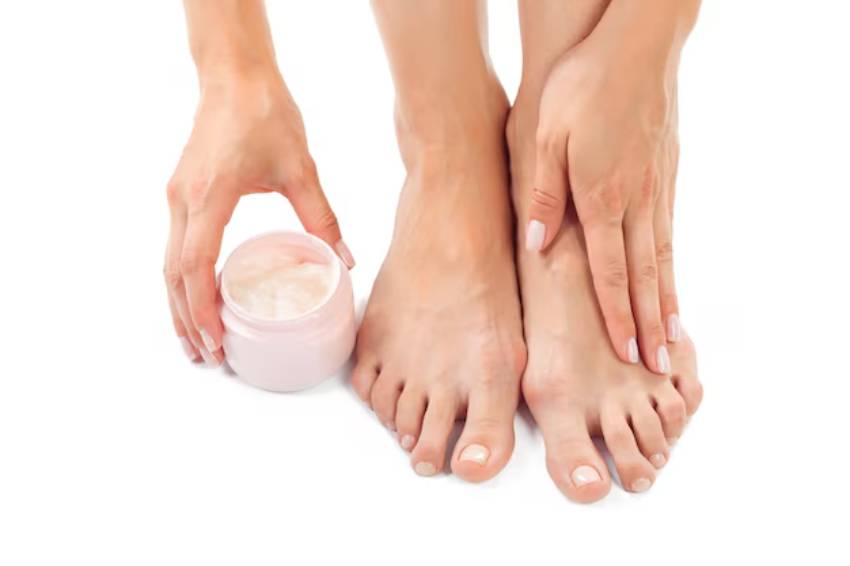What is Ingrown Toenail?
An ingrown toenail is a condition where the edge of the nail grows into the surrounding skin, causing pain, swelling, and sometimes infection. Ingrown toenails usually occur in the big toe but can also affect other toes. Common causes of ingrown toenails include improper nail trimming, wearing tight shoes, or trauma to the nail.
The first sign of an ingrown toenail is sensitivity and mild pain around the nail edge. If left untreated, the area around the nail edge can become red, swollen, and inflamed. If infection develops, there may be yellow or green pus around the nail. At this point, the ingrown toenail can become painful enough to interfere with daily activities.
Treatment methods include some home remedies. Soaking the foot in warm water, carefully trimming the ingrown nail, and keeping the nail area clean are usually sufficient for mild cases. However, if the condition worsens or shows signs of infection, professional help is necessary. At our clinic, effective methods applied by our experienced specialists can alleviate pain and prevent recurrence of ingrown toenails.

What are the Symptoms of Ingrown Toenail?
Ingrown toenail is a discomfort caused by nails growing into the skin. By correctly identifying the symptoms of ingrown toenails, I provide effective solutions to my patients. The most common symptoms include pain and tenderness around the nail edge. Redness and swelling may occur in the affected area. Over time, there is a risk of infection, which can manifest as inflammation and discharge.
Ingrown toenails can make daily activities difficult and reduce quality of life. Early intervention can prevent these symptoms from worsening. If you have difficulty wearing shoes or feel pain while walking, this situation should be taken seriously.
What Causes Ingrown Toenail?
An ingrown toenail occurs when the nail grows into the surrounding skin, causing pain. One of the most common causes of ingrown toenails is improper nail trimming. Cutting nails too short or rounding the edges can lead to the nail edges growing into the skin. Additionally, wearing tight or narrow shoes can cause ingrown toenails. The constant pressure applied by the shoe on the nail can cause the nail to grow into the surrounding skin.
Trauma to the nail is another common cause of ingrown toenails. Situations such as hitting the toe against something or dropping a heavy object on the foot can deform the nail structure and trigger ingrown toenail formation. Moreover, genetic factors can also predispose individuals to ingrown toenails. Some people have a natural nail structure and growth pattern that is more prone to ingrown toenails.
To prevent ingrown toenails, careful nail trimming and attention to foot health are essential. Cutting the nails straight and not rounding the edges are effective methods to prevent ingrown toenails. Additionally, wearing comfortable and foot-friendly shoes reduces the risk of ingrown toenails. If you are experiencing ingrown toenail problems, you can seek professional support at our clinic to get rid of this issue.
What Can Be Done to Prevent Ingrown Toenails?
Proper trimming is one of the most critical steps in preventing this problem. Cutting your nails straight and avoiding rounding the corners prevents the nail edges from growing into the skin. It is also important to avoid cutting the nails too short, as short nails can grow into the skin more easily.
Choosing the right shoes also plays a significant role in preventing ingrown toenails. Wearing tight and hard shoes that squeeze the toes can cause the nails to press into the skin and grow into it. Choosing comfortable and foot-friendly shoes helps maintain nail health.
Maintaining foot hygiene is also necessary to prevent ingrown toenails. Regularly washing and drying your feet prevents the formation of bacteria and fungi around the nails. Additionally, regularly checking your toenails allows you to detect any signs of ingrown toenails early and take preventive measures.
If you are prone to ingrown toenails or frequently experience this issue, seeking professional help is the best step. At our clinic, we apply the most suitable methods to prevent and treat ingrown toenails.
When Should I See a Doctor for Ingrown Toenails?
Ingrown toenails can initially present with mild pain and discomfort but may require professional help in some cases. If you notice redness, swelling, or tenderness around your nail edge and this condition does not improve within a few days, it is essential to see a doctor. Additionally, if you have difficulty walking or wearing shoes due to ingrown toenails, it indicates that you need medical assistance.
If the ingrown toenail shows signs of infection, you should see a doctor immediately. Signs of infection include intense redness around the nail, severe pain, increased warmth, and yellow or green pus discharge. Untreated infection can lead to serious health problems.
If you have chronic health issues such as diabetes or a weakened immune system, you should see a doctor immediately in the case of an ingrown toenail. In such conditions, the risk of infection is higher, and complications can be more severe.
How is Ingrown Toenail Diagnosed?
An ingrown toenail occurs when the edge of the nail grows into the skin, typically in the big toe, posing an infection risk. Causes include improper nail trimming, wearing tight shoes, trauma to the nail, and genetic predisposition. Symptoms include pain, swelling, redness, and inflammation around the nail edge.
Treatment methods aim to relieve pain and infection caused by the ingrown nail. In mild cases, proper nail trimming and appropriate shoe selection may be sufficient. In more advanced cases, surgical correction or partial removal of the nail may be necessary.
How is Ingrown Toenail Treated?
Treatment for ingrown toenails varies depending on the severity of the symptoms and how deeply the nail has grown into the skin. In mild cases, simple home remedies may be sufficient. These methods include proper nail trimming, soaking the affected area in warm water to soften the skin, and using antibacterial creams to reduce the risk of infection. Additionally, using cotton or special bandages to protect the skin around the ingrown nail can help guide the nail to grow properly and relieve pain.
In severe or chronic cases, medical intervention may be necessary. In such cases, the edge of the nail may be surgically removed under local anesthesia, or a portion of the nail bed may be removed. This surgical intervention aims to prevent the nail from growing into the skin again. Also, burning the nail edge with laser or phenol is a common method; this procedure helps prevent the nail from growing into the skin again. In cases with infection risk, antibiotic treatment may also be applied. Antibiotics prevent the spread of infection and support the healing process.
How to Get Rid of Ingrown Toenails?
The treatment of ingrown toenails involves various methods to stop the nail from growing into the skin and alleviate existing symptoms. Proper nail trimming is crucial; nails should be cut straight, and the corners should not be rounded. This way, the nail's growth into the skin can be prevented. In mild cases, soaking the affected area in warm water helps soften the skin around the nail and reduce the risk of infection. Additionally, applying antibacterial cream to the ingrown area can be effective in preventing infection.
In mild cases of ingrown toenails, placing a sterile cotton or dental floss under the nail can help lift the nail away from the skin. This method aids in guiding the nail to grow correctly. However, these procedures should be done carefully, following hygiene rules. If the ingrown toenail causes pain and swelling, pain relievers can provide temporary relief. However, these methods do not address the underlying cause, and further treatment may be necessary.
In more severe cases or situations that do not improve with home methods, medical intervention may be required. Interventions include the surgical removal of the nail edge or corner under local anesthesia. Additionally, advanced techniques such as partial nail bed removal or burning the nail root with a laser may be applied. These treatment methods offer permanent solutions to prevent the nail from growing into the skin again.
What are the Treatment Options for Ingrown Toenails?
Ingrown toenail is a painful condition where the edge or corner of the nail grows into the surrounding skin. Treatment options vary depending on the severity of the condition. In mild cases, simple home remedies can provide relief. Soaking the foot in warm water helps soften the skin around the nail, reducing pain and swelling. Using antibacterial creams or antiseptic solutions minimizes the risk of infection.
To prevent the nail from growing into the skin, proper trimming techniques should be used; nails should be cut straight, and the corners should not be left sharp. Sterile cotton or dental floss can be placed under the edge of the ingrown nail to prevent further damage to the skin. However, these methods should be applied carefully to avoid the risk of infection.
In more advanced cases, medical intervention is necessary. At our clinic, minor surgical procedures performed under local anesthesia involve removing the edge or corner of the nail. This procedure ensures the nail grows correctly without damaging the skin tissue. Advanced techniques such as partial nail bed removal or laser burning of the nail root may also be applied. These treatment methods offer permanent solutions to prevent the nail from growing into the skin again.
After treatment, detailed information is provided on proper shoe selection and nail care. Ensuring regular foot hygiene and nail trimming reduces the risk of ingrown toenails. Following the doctor's recommendations and regularly checking your nails are essential for preventing recurrence.



